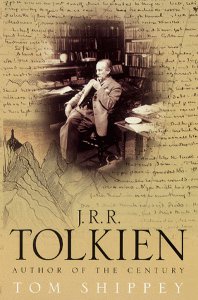 My current reading material is Tom Shippey’s JRR Tolkein: Author of the Century, a compilation of critical essays on Tolkiens work (and no prizes for guessing from the title that they’re largely very positive). It’s an absolutely superb book and one that I’d encourage anyone with more than a passing interest in Middle-Earth to acquire and read but I’ll save the details for a Trash Culture review piece sometime. Rather, Shippey raises a point almost at the beginning of the book that has wide ramifications for anyone, anywhere who likes fantasy, whatever they think of Tolkien himself, and it’s particularly pertinent to gamers.
My current reading material is Tom Shippey’s JRR Tolkein: Author of the Century, a compilation of critical essays on Tolkiens work (and no prizes for guessing from the title that they’re largely very positive). It’s an absolutely superb book and one that I’d encourage anyone with more than a passing interest in Middle-Earth to acquire and read but I’ll save the details for a Trash Culture review piece sometime. Rather, Shippey raises a point almost at the beginning of the book that has wide ramifications for anyone, anywhere who likes fantasy, whatever they think of Tolkien himself, and it’s particularly pertinent to gamers.
The observation in question is that the hobbits in the books, and particularly Bilbo in The Hobbit fulfil a role that anyone reasonably familiar with fantasy or sci-fi will recognise: a guide that the modern reader can identify with and use to help ease them into the unfamiliar surroundings of an imaginative world. The most common archetype for this is someone who is literally from our contemporary era but who suddenly finds themselves - for whatever reason - in a fantasy realm, such as Thomas Covenant from the Chronicles that bear his name. By use of this literary device the author can immediately give us a protagonist who knows as little about the world in which they find themselves as we do, thus making us immediately sympathetic to their plight as well as having a useful device to create mystery and, later, explain those mysteries to us.
Tolkien takes a slightly different route. Rather than giving us a genuine contemporary character to identify with, he subtly sets up the Shire and its inhabitants as a place and a people with whom many readers of the day would have a shared culture. Look at Bilbo’s home: it’s underground of course and in that way it seems fantastic and alien to a modern-day reader but much else about it is instantly recogniseable: it has a hall, a pantry, a drawing room, even a bath and several guest bedrooms. This is a million miles away from the grand castles, gloomy caves or lowly huts that we would presume an inhabitant of a mock-medieval fantasy would dwell in and has far more in common with a comfortable, middle-class Edwardian family home. The Shire also has a number of curious cultural and technological innovations which are extremely recent in origin such as a postal service, a relatively enlightened form of government, clocks and pocket watches, handkerchiefs and waistcoats and various other anachronisms. Bilbo might immediately establish his fantasy credibility by being four foot high, having bare hairy feet and living underground but he’s equally obviously a reasonably well-off Edwardian gentleman. The fact that so few people (including me) ever spot this contradiction is a testament to Tolkien’s skill as a writer.
So far, so good. It’s a common literary device and having established it, Tolkien rapidly moves on from the Shire in both his hobbit-books and plunges the protagonists into a dangerous world far more invested with the trappings of medievalism that we have been expecting. He can forget about his anachronisms and not bother to examine them again. But whilst it’s not problem for Tolkien it does present a problem to his predecessors which is pretty much the entire fantasy genre. You see, one part of Tolkien’s genius was that he created the illusion of depth in his fantasy world by giving it a rich mythology, history and by using his extensive knowledge of languages to create names and cultural motifs that feel real and valid and serve to make the reader unconsciously bind together the members of one of the many and varied civilizations of Middle-Earth and pretty much no author following him has ever been capable to doing the same thing. Instead both fans and authors look at his work and what they perceive is simply detail. And so lacking the ability to mimic the sort of detail that Tolkein created they instead substitute much shallower, mechanical details: dates and places for real history and mythological sweep, clothes and mannerisms for rich culture, ever more complex maps and geographies for linguistic cohesion.
The issue with these kinds of detail is simply that because they don’t trigger the sorts of subconscious association making in the reader that languages and myths do (since we’re steeped in them as we grow up) they instead rely on seeming directly believable. Few modern fantasy authors would get away with the huge sleights of hand that Tolkien does regarding the mechanics of their imaginary worlds, the most obvious of which is the many times that Tolkien ducks the question of what exactly “Elvish magic” is and how it works. Readers nowadays, provided with ever increasing amounts of shallow information about the fantasy world they’re scrutinising would expect an explanation of how magic works in that world that makes sense when fitted together with all the rest of the surface detail. And yet, such is the impact of Tolkien on the genre - and indeed it must also be allowed such is the promise of variety allowed by the genre - that readers also expect to see the sorts of anachronisms presented by the hobbits as a simple literary device present in that world.
This immediately creates a huge problem. If one culture in your fantasy world has pocket-watches where did they get them from? Where are the pre-requisite other advances in science and technology that allowed them to invent the pocket watch? Why haven’t other neighbouring cultures in the world managed to copy the pocket watch? Suddenly, because all the surface detail has to make sense, these questions, that Tolkien managed to skip past, need answers. And there simply is no satisfactory answer. Suspension of disbelief is shattered. The problem becomes even more acute when one considers cultural innovations such as the postal service. No-one would mind much if an author left out some of the technological oddities in the name of cohesion, but readers to tend to expect to see cultural aspects of a fantasy world that mimic things in the contemporary world, not least because to most people the medieval mindset is all but-impenetrable centuries later. This sets up an inevitable stylistic clash.
Authors can generally manage to get around this problem for two reasons. Firstly, due to limited time and space readers don’t usually expect them to explain the entirety of their creations in laborious detail. Second because they’re in control of the plot they can simply avoid or skip rapidly past sections of narrative that would highlight these anachronisms. And this is where the issue becomes important to gamers because in a game world - particularly a role-playing game world - neither of these things is possible. There will be an army of fans with the time and the motivation to pick over and examine the most intricate detail of the created world, and because the world itself (unlike the plot of the game campaign) is something shared between designers, games-masters and players there’s no way of glossing over the cracks. Hence the sorts of pointless, annoying fan-boy arguments we’ve all witnessed around the gaming table about the plausibility of some facet or other of the game world.
So what’s the answer? Clearly the only approach is not hold up such high standards of believability. Use some imagination: this is supposed to be fantasy after all. Perceiving this sort of thing as an “issue” is really something that’s only in the realms of the most die-hard and obnoxious obsessives in any case. But the next time you encounter one you’ll have a counter-argument and an explanation. And if you find yourself wanting to blame someone as you sit and grind your teeth whilst listening to the latest rant as to why Gnomish culture could never possibly have invented custard you have a target: blame Tolkien.
- Books and Comics
- Squaring Circles: Anachronism in Fantasy
Squaring Circles: Anachronism in Fantasy
Hot
MT
Matt Thrower
Updated
7533
0
There Will Be Games

Discuss this article
Log in to comment Games
Games How to resolve AdBlock issue?
How to resolve AdBlock issue? 
